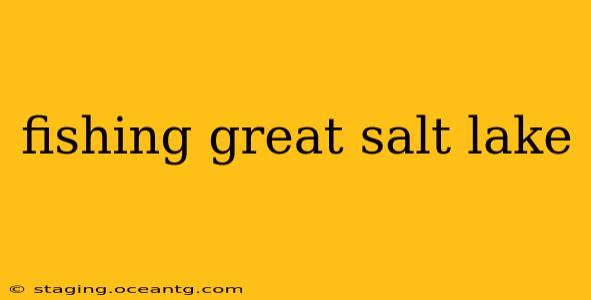The Great Salt Lake, a massive inland saltwater lake in Utah, presents a unique and challenging fishing experience unlike any other. Its high salinity, fluctuating water levels, and specific fish populations require specialized techniques and gear. This guide dives deep into the art of fishing the Great Salt Lake, addressing common questions and providing insights for a successful outing.
What kind of fish are in the Great Salt Lake?
The Great Salt Lake's high salinity limits the types of fish that can survive. The most prominent species is the Bonneville cutthroat trout, a subspecies uniquely adapted to the lake's harsh environment. You'll also find longfin dace, a small minnow-like fish, and occasionally, other species introduced over time. The salinity levels directly impact the fish population and distribution, making certain areas more productive than others.
Where is the best place to fish in the Great Salt Lake?
There's no single "best" place, as productive fishing spots depend heavily on the time of year, water levels, and the specific target species (primarily Bonneville cutthroat trout). However, several areas are known for consistent activity. These often include the northern and southern arms of the lake, where freshwater tributaries influence salinity and provide crucial habitat. Local fishing reports and guides can provide the most up-to-date information on hot spots.
What is the best time of year to fish the Great Salt Lake?
The best time to fish the Great Salt Lake largely depends on the target species and your preferences. Generally, spring and fall offer the most comfortable weather conditions for fishing. Summer can be extremely hot, while winter brings the challenge of cold temperatures and potential ice. However, each season presents opportunities; understanding the fish behavior and adapting your approach is key.
What kind of bait or lures work best in the Great Salt Lake?
Given the unique environment, choosing the right bait or lure is crucial. Small, brightly colored lures often prove effective for Bonneville cutthroat trout. Some anglers use small jigs, spinners, and flies, employing techniques similar to those used in freshwater streams and rivers. Experimentation is key, as fish can exhibit varied preferences depending on conditions.
What equipment do I need to fish the Great Salt Lake?
Fishing the Great Salt Lake requires specialized equipment due to the high salinity. Standard freshwater fishing rods and reels can be used, but ensure your equipment is thoroughly rinsed with fresh water after each outing to prevent corrosion. Consider using braided line, which is less susceptible to damage from saltwater. Appropriate waders are crucial, as you might wade into shallow areas to reach productive spots. Finally, polarized sunglasses are highly recommended to see through the often murky water.
Are there any restrictions on fishing in the Great Salt Lake?
Yes, there are fishing regulations specific to the Great Salt Lake. It's crucial to check with the Utah Division of Wildlife Resources (DWR) website for up-to-date information on licenses, bag limits, and size restrictions for Bonneville cutthroat trout and other species. Understanding and following these regulations is essential for responsible fishing and the conservation of this unique ecosystem.
What are some tips for successful fishing in the Great Salt Lake?
Successful fishing in the Great Salt Lake demands patience and adaptability. Stay informed about current water levels and fish activity through local fishing reports and guides. Experiment with different techniques and lures. Use polarized sunglasses to improve your visibility underwater. Remember to thoroughly rinse your equipment with fresh water after each trip to prevent corrosion. Most importantly, respect the environment and adhere to all fishing regulations.
This guide offers a starting point for your Great Salt Lake fishing adventure. Remember to always prioritize safety, respect the environment, and thoroughly research the latest regulations and conditions before embarking on your trip. Tight lines!
